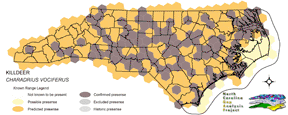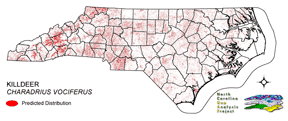
| Taxa: |
| Order: |
| Family: |
| Aves |
| Charadriiformes |
| Charadriidae |
| NatureServe Global Rank: |
| NatureServe State (NC) Rank: |
| G5 |
| S5B,S5N |
| Federal Status: |
| NC State Status: |
| --- |
| --- |


| Land Unit |
| US Fish & Wildlife Service |
| US Forest Service |
| US National Park Service |
| US Department of Defense |
| NC State Parks |
| NC University System |
| NC Wildlife Res. Com. |
| NC Forest Service |
| NC Div. of Coastal Mgmt. |
| Local Governments |
| Non-Governmental Org. |
| Other Public Lands |
| Private Lands |
| GAP Status 1-2 |
| All Protected Lands |
| Statewide |
| Hectares |
| 1,736.37 |
| 11,224.17 |
| 8,541.54 |
| 8,391.87 |
| 1,218.51 |
| 151.74 |
| 1,615.23 |
| 443.49 |
| 429.21 |
| 319.86 |
| 458.37 |
| 491.40 |
| 1,330,297.56 |
| 10,419.36 |
| 34,505.70 |
| 1,365,319.32 |
| Acres |
| 4,290.66 |
| 27,735.52 |
| 21,106.60 |
| 20,736.76 |
| 3,011.00 |
| 374.96 |
| 3,991.32 |
| 1,359.94 |
| 1,060.60 |
| 790.39 |
| 1,132.66 |
| 1,214.28 |
| 3,287,236.22 |
| 26,010.85 |
| 85,529.48 |
| 3,374,040.91 |
| % of Dist. on |
| Prot. Lands |
| 5.0 % |
| 32.5 % |
| 24.6 % |
| 24.3 % |
| 3.5 % |
| 0.4 % |
| 4.2 % |
| 1.3 % |
| 1.2 % |
| 1.2 % |
| 1.2 % |
| 0.7 % |
| < 0.1 % |
| 30.2 % |
| ----- |
| ----- |
| % of Dist. on |
| All Lands |
| 0.1 % |
| 0.8 % |
| 0.6 % |
| 0.6 % |
| < 0.1 % |
| < 0.1 % |
| 0.1 % |
| < 0.1 % |
| < 0.1 % |
| < 0.1 % |
| < 0.1 % |
| < 0.1 % |
| 97.4 % |
| 0.8 % |
| ----- |
| ----- |
|
Found across most of the state (Potter et al. 1980). Common in the mountains, uncommon and local on the coast (Fussell 1994), and occasional on the barrier islands (Fussell and Lyons 1990). Found in a variety of open agricultural and short-grass areas, often near human habitation (Hayman et. al. 1986). Examples include wet fields (Simpson 1992), pastures, mudflats, golf courses (Potter et al. 1980), lawns, parking lots, roadsides, airports, cemeteries (Harrison 1975), gravel roads (Kaufman 1996) and gravel pits. Attracted to gravelly substrates (Johnsgard 1981). For breeding, killdeer require an open area, soft ground, little or no vegetation, and the presence of stones, pebbles, gravel, etc. (Ehrlich et al. 1988); the nest is often located next to some kind of object (Johnsgard 1986). Birds also will occasionally nest on the flat roof of a house (Hayman et al. 1986). NATURE SERVE GLOBAL HABITAT COMMENTS: Fields, meadows, pastures, mudflats, and shores of lakes, ponds, and rivers, less commonly along seacoasts (AOU 1983). Nests on ground in open dry or gravelly situations, sometimes in similar situations on roofs, driveways, etc. |
| Code | Name | Description | NC Natural Heritage Program Equivalent |
| 378 | Ocean Beaches | Open beach sand. | Upper Beach |
| 375 | Hypersaline coastal salt flats | Tidal flats within salt marshes, including saltmeadow cordgrass or sea-purslane dominated alliances. | Salt Marsh |
| 372 | Interdune Herbaceous Wetlands | Dune swales with permanently flooded to intermittently exposed hydrology. Species composition depends on salinity and can include cut grass, spike-rush, mosquito fern, and hornwort. | Interdune Pond, Maritime Wet Grasslands |
| 371 | Maritime Grasslands | Dune grass community consisting of sea oats and beach grasses. | Dune grass, Maritime dry grassland |
| 205 | Agricultural Pasture/Hay and Natural Herbaceous | Farm fields used for pasture grass or hay production, as well as old fields dominated by native and exotic grasses. | No equivalent |
| 60 | Sand | Exposed sand, predominantly in the sandhills region where disturbance or the extreme site conditions prevent natural regeneration. | No equivalent |
| 202 | Residential Urban | Includes vegetation interspersed in residential areas. Includes lawns, mixed species woodlots, and horticultural shrubs. Vegetation accounts for between 20 - 70% of the cover. | No equivalent |
|
Nol, E. and R.J. Brooks. 1982. Effects of predator exclosures on nesting success of killdeer. J. Field Ornithology., 53:263-268.
Bent, A.C. 1929. Life histories of North American shore birds. Part II. U.S. National Museum Bulletin No. 146. Washington, D.C. Simpson MB Jr. 1992. Birds of the Blue Ridge Mountains. Chapel Hill and London: University of North Carolina Press. Fussell, J. III and M. Lyons. 1990. Birds of the Outer Banks [pamphlet]. Eastern National Parks and Monument Association Coastal Wildlife Refuge Society. Fussell, J.O. III. 1994. A birderís guide to coastal North Carolina. Chapel Hill and London: The University of North Carolina Press. Kaufman K. 1996. Lives of North American Birds. Boston, New York: Houghton Mifflin Company. Harrison, H.H. 1975. A field guide to bird's nests in the U.S. east of the Mississippi River. Houghton Mifflin Company, Boston, Massachusetts. 257 p. Harrison, H.H. 1979. A field guide to western birds' nests. Houghton Mifflin Company, Boston. 279 pp. Potter, E. F., J. F. Parnell, and R. P. Teulings. 1980. Birds of the Carolinas. Univ. North Carolina Press, Chapel Hill. 408 pp. Terres, J.K. 1980. The Audubon Society encyclopedia of North American birds. Alfred A. Knopf, New York. Johnsgard, P. A. 1981. The plovers, sandpipers, and snipes of the world. University of Nebraska Press, Lincoln, Nebraska. 493p. American Ornithologists' Union (AOU), Committee on Classification and Nomenclature. 1983. Check-list of North American Birds. Sixth Edition. American Ornithologists' Union, Allen Press, Inc., Lawrence, Kansas. Raffaele, H.A. 1983. A guide to the birds of Puerto Rico and the Virgin Islands. Fondo Educativo Interamericano, San Juan, Puerto Rico. 255 pp. Hayman, P., J. Marchant and T. Prater. 1986. Shorebirds. An identification guide to the waders of the world. Boston: Houghton Mifflin Company. Ehrlich, P.R., D.S. Dobkin, and D. Wheye. 1988. The birder's handbook:a field guide to the natural history of North American birds. Simon and Shuster, Inc., New York. xxx + 785 pp. Stiles, F.G., and A.F. Skutch. 1989. A guide to the birds of Costa Rica. Comstock Publ. Associates, Cornell University Press, Ithaca, New York. 511 pp. |
For more information please contact them at:
NC-GAP Analysis Project
Dept. of Zoology, NCSU
Campus Box 7617
Raleigh, NC 27695-7617
(919) 513-2853
www.basic.ncsu.edu/ncgap